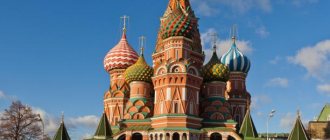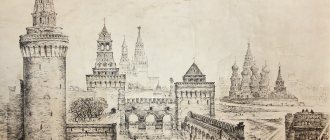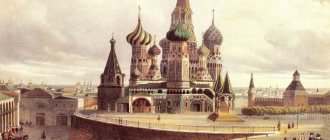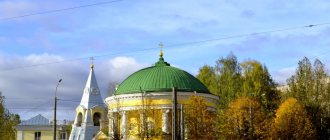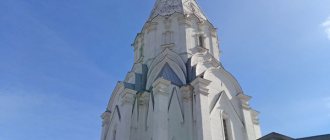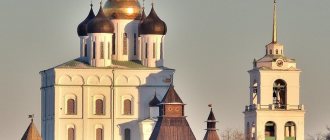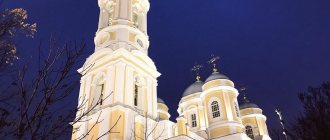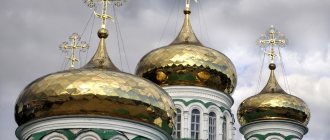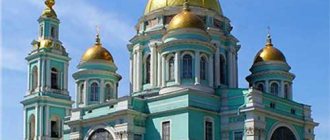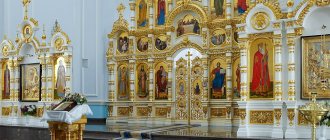St. Basil's Cathedral in Moscow is a more colloquial definition of the Cathedral of the Intercession of the Blessed Virgin Mary, which is on the Moat (another name is St. Basil's Cathedral).
The Orthodox religious building is located on Red Square and until the 17th century it was called the Trinity Church, because the first wooden church on this site was consecrated in honor of the Holy Trinity.
In ancient times, the people also called the cathedral the Jerusalem Cathedral, which was associated with the religious procession held on Palm Sunday. It began with the Assumption Cathedral of the Moscow Kremlin and was accompanied by a “procession on a donkey” of the Russian Patriarch.
ADDITIONAL INFORMATION: ADDRESS. TELEPHONE. HOW TO GET THERE
Address: Moscow Red Square, 7 (metro station Ploshchad Revolyutsii, Teatralnaya, Okhotny Ryad, Kitay-Gorod) Phone (administrator) Official website: shm.ru
Opening hours: September 1 – November 4: 11:00–18:00, daily; November 5 – April 30: 11:00–17:00, daily; May 1 – May 31: 11:00–18:00, daily. The first Wednesday of the month is a sanitary day; June 1 – August 31: 10:00–18:00, daily. The ticket office and area close 45 minutes before. until the museum closes. In summer, the territory of the Intercession Cathedral is open from 9:00 to 19:00, daily. At temperatures below -15, the museum reduces its opening hours. Please check the museum's closing time by phone. During the winter and spring school holidays, the museum's opening hours are extended by 1 hour.
Museum
After the cessation of services, by decision of the Soviet government, the temple building was built in the early 1920s. began to be used as a historical and architectural museum. An exposition opens there, funds are formed, and research work begins.
Since 1928, the museum has become a division of the State Historical Museum. His exhibition activities had an anti-religious orientation. In parallel with the work of the exhibition part, large-scale restoration measures are being carried out in the building.
The museum ceased operation in the period 1941-1947. Over the years, thematic collections dedicated to the construction and architecture of the 16th century, bibliography of the 16th-20th centuries, and the conquests of Ivan the Terrible were presented in the room.
The Church of the Intercession is one of the main tourist sites in the capital. Since 1991, along with the museum, religious activities have been resumed there.
Main collections:
- weapons 15-16 centuries.
- bells 16-20 centuries.
In 2014, the permanent exhibition “Treasures of the Intercession Cathedral” was presented to visitors. In the lower part of the building, tourists get acquainted with the history of the temple. In the upper part, the public examines ancient interiors with elements of paintings and sculptures by masters of ancient Russian art.
Photo gallery
Working hours
Opening hours vary throughout the year and depend on the season. And also weather conditions. When the temperature drops below -15C°, the temple complex remains closed.
| Schedule | 1.06-24.08 | 25.08-3.09 | 1.05-31.05 and 4.09-7.11 | 8.11-30.04 |
| Work time | 10-19 hours | 10-16 hours | 11-18 h. | 11-17 h. |
| Day off | Wednesday | Wednesday | No | No |
Sanitation day is held monthly on the first Wednesday.
St. Basil's Cathedral history
Anyone who enters Red Square immediately notices the bright domes and graceful contours of St. Basil's Cathedral.
Construction of the temple lasted 9 years. The architects were, according to one version, the masters Postnik and Barma, and according to another, an unknown architect. The legend agrees on only one thing - the builders of the temple were blinded by order of Ivan the Terrible.
At first it was a memorial complex of a tented church surrounded by 9 small churches - symbols of major victories over Kazan. The famous figured domes appeared at the end of the 16th century, and a little later a bell tower was built there. During its history, the cathedral suffered from many misfortunes - first, a fire in 1737 destroyed it almost completely, then the cathedral was damaged during the siege of the city by Napoleon's troops. In Soviet times they even wanted to demolish it.
Now the temple is used for worship and as a memorial and historical complex. Its churches house religious relics - the relics of St. John the Wonderworker, ancient icons and religious objects.
The official name of this majestic temple is the Cathedral of the Intercession of the Blessed Virgin Mary on the Moat. But for most tourists around the world it is known as St. Basil's Cathedral, a brief description
which you will find in this article.
He successfully survived the change of eras and ruling elites, numerous wars and revolutions, and even the Soviet fight against religion. Today, St. Basil's Cathedral in Moscow
remains its main attraction, the calling card of the capital.
History of the cathedral
It is not known exactly what stood before on the site of the Intercession Cathedral. Russian chronicles contain fragmentary and contradictory reports about wooden and stone churches. This gave rise to many guesses, versions and legends.
According to one version, soon after the return of Ivan IV the Terrible from the Kazan campaign of 1552, on the site of the future Church of the Intercession on the Moat on the edge of the Moscow River, a wooden church in the name of the Life-Giving Trinity with seven chapels was founded on a hill.
Saint Metropolitan Macarius of Moscow advised Ivan the Terrible to create a stone church here. Metropolitan Macarius also came up with the main compositional idea for the future church.
The first reliable mention of the construction of the Church of the Intercession of Our Lady dates back to the autumn of 1554. It is believed that it was a wooden cathedral. It stood for a little over six months and was dismantled before the construction of the stone cathedral began in the spring of 1555.
The Intercession Cathedral was built by Russian architects Barma and Postnik (there is a version that Postnik and Barma are the names of the same person). According to legend, so that the architects could not create a new and better creation, Tsar Ivan IV, upon completion of the construction of an outstanding masterpiece of architecture, ordered them to be blinded. This fiction was subsequently proven to be untenable.
The construction of the temple took only 6 years and only in the warm season. The chronicle contains a description of the “miraculous” acquisition by the masters of the ninth, southern throne, after the entire structure was almost completed. However, the clear symmetry inherent in the cathedral convinces us that the architects initially had an idea about the compositional structure of the future temple: it was planned to build eight chapels around the central ninth church. The temple was built of brick, and the foundation, plinth and some decorative elements were made of white stone.
By the autumn of 1559 the cathedral was basically completed. On the Feast of the Intercession of the Mother of God, all the churches were consecrated, with the exception of the central one, since “the larger church, the middle Intercession, was not completed that year.”
The consecration of the Intercession Church and, accordingly, the entire cathedral took place on July 12 (June 29, old style) 1561. Metropolitan Macarius consecrated the temple.
Each church of the cathedral received its own dedication. The Eastern Church was consecrated in the name of the Holy Life-Giving Trinity. Researchers are still looking for an answer to why this church got its name. There are several hypotheses. It is known that in honor of the “Holy Life-Giving Trinity” a monastery was founded in 1553 in conquered Kazan. It is also believed that on the site of the Intercession Cathedral there originally stood a wooden Trinity Church, which gave its name to one of the chapels of the future temple.
Four side chapels are consecrated in honor of the saints, on whose memory days the most important events of the Kazan campaign took place: Cyprian and Justina (October 2 (15) - on this day the assault on Kazan ended), Gregory, the enlightener of Great Armenia (on his memory day September 30 (13 October) there was an explosion of the Arsk tower in Kazan), Alexander Svirsky (on his memorial day, August 30 (September 12), a victory was won over the army of Tsarevich Epancha, who was rushing from Crimea to help the Tatars), Three Patriarchs of Constantinople Alexander, John and Paul the New ( also commemorated on August 30).
Three more chapels are dedicated to Nikolai Velikoretsky, Varlaam Khutynsky and the Feast of the Entry of the Lord into Jerusalem. The central throne is named in honor of the Intercession of the Virgin Mary, since on October 1 (14), on the day of this holiday, symbolizing the intercession of the Mother of God for the Christian race, the main assault on Kazan began. The entire cathedral was named after the central church.
The prefix “on the Moat,” found in chronicles about the cathedral, is due to the fact that across the entire square, later called Red, along the Kremlin wall from the 14th century there was a deep and wide defensive ditch, which was filled in in 1813.
The cathedral had an unusual architectural composition - 9 independent churches were built on a single foundation - a basement - and connected to each other by internal vaulted passages surrounding the central temple. Outside, all the churches were surrounded by an initially open gallery-promenade. The central church ended with a high tent, the chapels were covered with vaults and topped with domes.
The ensemble of the cathedral was complemented by a three-hipped open belfry, in the arched spans of which massive bells hung.
Initially, the Intercession Cathedral was crowned with 8 large domes and a small dome over the central church. To emphasize the importance of the building material, as well as to protect the cathedral from atmospheric influences, all its exterior walls were painted in red and white colors. The painting imitated brickwork. The material of the original covering of the domes remains unknown, since they were lost during a devastating fire in 1595.
The cathedral existed in its original form until 1588. Then a tenth church was added to it on the north-eastern side over the grave of the holy fool St. Basil, who spent a lot of time near the cathedral under construction and bequeathed to be buried next to it. The famous Moscow miracle worker died in 1557, and after his canonization, the son of Tsar Ivan IV the Terrible, Fyodor Ioannovich, ordered the construction of a church. Architecturally, it was an independent pillarless temple with a separate entrance.
The place where the relics of St. Basil were found was marked with a silver shrine, which was subsequently lost during the Time of Troubles, at the beginning of the 17th century. Divine services in the saint’s church soon became daily, and starting from the 17th century, the name of the chapel was gradually transferred to the entire cathedral, becoming its “popular” name: St. Basil’s Cathedral.
At the end of the 16th century, figurative domes of the cathedral appeared to replace the original burnt covering.
In 1672, an eleventh church was added to the cathedral on the south-eastern side: a small temple over the tomb of John the Blessed, the revered Moscow holy fool, buried near the cathedral in 1589.
In the second half of the 17th century, significant changes occurred in the appearance of the cathedral. The wooden canopies over the walkway, which burned down every now and then in fires, were replaced with roofing on arched brick pillars. The Church of St. Theodosius the Virgin was built above the porch of the Church of St. Basil the Blessed. Above the previously open white stone stairs leading to the upper tier of the cathedral, vaulted hipped porches appeared, built on the so-called “creeping” arches.
In the same period, polychrome ornamental painting appeared. It covers the newly built porches, support pillars, outer walls of galleries and parapets of walkways. At this time, the facades of churches retain paintings imitating brickwork.
In 1683, the entire cathedral along the upper cornice was surrounded by a tiled inscription. Large yellow letters on a dark blue background of watered tiles reported on the history of the creation of the temple and its renovation in the second half of the 17th century. The inscription was destroyed a century later during another renovation.
In the 1680s. The belfry was rebuilt. In place of the open structure, a two-tier bell tower with an open upper platform for ringing was erected.
In 1737, during a huge fire, St. Basil's Cathedral was badly damaged, especially its southern church.
Dramatic changes in its painting program occurred during renovations in the 1770s and 1780s. The thrones of wooden churches demolished to prevent fires from Red Square were moved to the territory of the cathedral and under its vaults. At the same time, the throne of the Three Patriarchs of Constantinople was renamed in the name of John the Merciful, and the Church of Cyprian and Justina began to bear the name of Saints Adrian and Natalia (the original dedications to the churches were returned in the 1920s).
The inside of the church was painted in oil with a “storyline” letter depicting saints and hagiographic scenes. Oil painting was renewed in 1845-1848. and at the end of the 19th century. The outside walls were covered with paintings that imitated masonry made of large boulders - “wild stone”. The arches of the basement (lower non-residential tier) were laid, in the western part of which housing for the clergy (temple servants) was placed. The bell tower was combined by an extension with the cathedral building. The upper part of St. Basil's chapel (Church of Theodosius the Virgin) was rebuilt into a sacristy - a repository of church valuables and shrines.
In 1812, the order was given to French artillerymen to blow up the cathedral. However, it was only plundered by Napoleon's troops, but immediately after the war it was repaired and consecrated. The area around the cathedral was landscaped and surrounded by an openwork cast-iron lattice, designed by the famous architect O. Bove.
At the end of the 19th century, the task of returning the cathedral to its original appearance arose for the first time. The specially created Commission for the restoration of the monument included famous architects, scientists and painters, who determined the main directions of research and restoration of the Intercession Cathedral. However, the lack of funds, the October Revolution and the subsequent period of devastation in the history of Russia did not allow the implementation of the planned program.
In 1918, the Intercession Cathedral was one of the first to be taken under state protection as a monument of national and world significance. Since May 21, 1923, it has been open to visitors as a historical and architectural museum. Moreover, until 1929, services were held in the Church of St. Basil the Blessed.
In 1928, the Intercession Cathedral became a branch of the State Historical Museum and remains so to this day.
In the 1920s Extensive scientific restoration work was carried out on the monument, thanks to which it became possible to restore the original appearance of the cathedral and recreate the interiors of the 16th - 17th centuries in individual churches.
From this moment to the present, four global restorations have been carried out, including architectural and pictorial works. The original 16th-century “brick-like” painting was restored outside, in the Church of the Intercession of the Mother of God and in the Church of Alexander Svirsky.
In the 1950s-1960s. Unique restoration work was carried out: a “temple chronicle” was opened in the interior of the central church, in which the ancient architects indicated the exact date of completion of the cathedral - July 12, 1561 (the day of Equal-to-the-Apostles Peter and Paul); For the first time, the iron coverings of the domes were replaced with copper ones. The successful choice of material contributed to the fact that the dome coverings remain undamaged to this day.
In the interiors of four churches, iconostases were reconstructed, almost entirely consisting of icons from the 16th - 17th centuries, among which there are genuine masterpieces of the Old Russian school of icon painting (“Trinity” of the 16th century). The pride of the collection are the icons of the 16th-17th centuries. “Vision of the Sexton Tarasius”, “Nikola Velikoretsky in the Life”, “Alexander Nevsky in the Life”, as well as icons from the original iconostasis of the Church of the Intercession of the Blessed Virgin Mary “Basily the Great” and “John Chrysostom”. In the remaining churches, iconostases from the 18th - 19th centuries have been preserved. Among them, two iconostases were moved in the 1770s. from the cathedrals of the Moscow Kremlin (altar barriers in the Church of the Entry of the Lord into Jerusalem and in the central church).
In the 1970s On the outer bypass gallery, under the later entries, a 17th-century fresco was discovered. The found painting served as the basis for recreating the original ornamental painting on the facades of the cathedral.
The year 1990 was an important milestone in the history of the museum: the Intercession Cathedral was included in the List of UNESCO World Heritage Sites in Russia. After a long break, services were resumed in the Church of the Intercession of the Blessed Virgin Mary. The following year, the cathedral was approved for joint use by the State Historical Museum and the Russian Orthodox Church.
In 1997, the restoration of the interior, monumental and easel paintings was completed in St. Basil's Church, closed since the late 1920s. The church was included in the exhibition of the Intercession Cathedral, and divine services were resumed there.
The Russian Orthodox Church holds divine services in the Intercession Cathedral: on the days of the main altars (the Intercession and St. Basil), patriarchal or lordly services are held. Every Sunday an akathist is read at the shrine of St. Basil the Blessed.
In 2001-2011 The seven churches of the cathedral were completely restored, the façade paintings were renewed, and the tempera painting of the internal gallery was partially renewed. In 2007, the Intercession Cathedral became a nominee for the “Seven Wonders of Russia” competition.
Description
The Orthodox Church is located on Red Square, next to the monument to Minin and Pozharsky, opposite the Historical Museum. The architectural complex consists of nine churches on one foundation. Reaching 65 meters in height, the cathedral is crowned with 11 bells: nine of them are the domes of the church, one is above the bell tower and another one is above the chapel.
Churches are symbols of religious holidays during the capture of the Kazan Khanate. This decision was not made by chance, since St. Basil's Cathedral was built in honor
this significant event in the history of the country, by order of Tsar Ivan the Terrible.
All domes are made in bright colors, none of them is the same in texture or color design. The churches are connected by arched passages and galleries.
Although the official name of the temple is the Cathedral of the Intercession of the Blessed Virgin Mary, throughout the world it is known primarily as St. Basil's Cathedral. Holy fools were called blessed, and they were treated with due respect in Moscow. Vasily was the most famous holy fool of the city and was distinguished by deep piety and the gift of prediction, which is why his name gave the cathedral another name, more widely known.
Interiors
The cathedral is distinguished by its decorative appearance, polychrome ornaments and paintings, and skillful combination of various architectural elements.
The complex stands on a single basement, replacing the foundation. The vaults inside the buildings are supported by pillars. For ventilation, narrow slotted holes in the walls are used - vents. Natural light enters the interior through a light drum under the dome of the church.
The decoration of the chapels is distinguished by the combination of colors and style of painting. The frescoes were painted with oil paints. The temple contains a huge collection (over 400) of icons (16-19 centuries). Most of them were created by Novgorod and Moscow painters.
St. Basil's Cathedral inside
The general view of the Intercession Cathedral is so famous that not all tourists know that there are museum exhibitions inside and excursions are held. To better understand the meaning and history of St. Basil's Cathedral on Red Square,
should go inside.
The first thing that fascinates a tourist is the picturesque passage galleries between churches, reminiscent of colorful images from Russian folk tales. The walls and domes are painted with the faces of saints and images from their lives. The temple has many ancient icons and frescoes made in the 16th and 17th centuries. The paintings were updated several times in the mid and late 19th century.
Inside St. Basil's Cathedral
You can take
photos
with the flash turned off.
Today, the Cathedral houses a branch of the State Historical Museum, where, in addition to icons and church utensils, you can see samples of ancient weapons and bells cast several centuries ago.
Current state of the temple
Today the cathedral has been completely restored and is functioning, combining the functions of a museum and a place for worship on Sundays and Easter.
In 2008, the Intercession Cathedral received the status of one of the seven wonders of Russia, and in 2022 it was included in the list of UNESCO World Heritage Sites, being a unique architectural monument and the pride of Russian Orthodoxy.
How the temple was created
Construction of the cathedral began in 1555 and lasted until 1561. During restoration work in the 20th century, the exact date for the opening of the cathedral was established - July 12, 1561, the day of Saints Peter and Paul.
It is not known for certain who built St. Basil's Cathedral
. There are several versions in which historical facts are firmly intertwined with legends.
According to the first of them, the construction was supervised by the architect Postnik Yakovlev from Pskov and the master Ivan Barma (many argue that it was the same person). According to city legends, upon completion of construction they were blinded in order to deprive the craftsmen of the opportunity to repeat such a masterpiece.
However, historians have already proven that this version is nothing more than a legend, since it is precisely established that Postnik later took part in the construction of the Kremlin in Kazan. There is also a version that the cathedral was built without a single drawing, and a diagram drawn right on the construction site served as a guide.
According to the second version, another architect took part in the construction of the temple, whose name remains unknown. Presumably, he was from Italy, so characteristic elements of the European Renaissance are noticeable in the architectural style of the temple. But no official documents confirming this version have survived either.
The Legend of the Tsar and the Blinded Builders
The most common myth about the cathedral is the chilling story that Tsar Ivan IV allegedly ordered its builders, Postnik and Barma, to be blinded so that they would never be able to build anything else that could surpass and eclipse the newly erected architectural masterpiece. Meanwhile, there is no real historical evidence of this.
Yes, the builders of the temple were really called Postnik and Barma. In 1896, Archpriest John Kuznetsov, who served in the temple, discovered a chronicle in which it was said that “The pious Tsar John came from the victory of Kazan to the reigning city of Moscow... And God gave him two Russian masters named Postnik and Barma and was wise and convenient for such a wonderful work ..." This is how the names of the cathedral’s builders became known for the first time. But there is not a word about blindness in the chronicles.
Moreover, after completing the work in Moscow, Ivan Yakovlevich Barma took part in the construction of the Annunciation Cathedral in the Moscow Kremlin, the Kazan Kremlin and other iconic buildings, which are mentioned in the chronicles.
Cathedral in different years
St. Basil's Cathedral was rebuilt and restored several times. This was due to frequent fires on Red Square, where wooden houses were mainly built. Over time, the wooden canopies were replaced with roofing, vaulted tents were built over the white stone stairs, and a two-level bell tower with an open area for bell ringers was erected.
In the 19th century, significant changes took place in the interior decoration of the cathedral. On the walls, oil paintings depicted the faces of saints and scenes from their lives. The walls were decorated with a pattern reminiscent of large stone masonry.
During the Patriotic War of 1812, the troops of Napoleon Bonaparte kept their horses in the basement of the Intercession Church. The emperor himself admired the beauty of the cathedral so much that he even planned to move it to France. Convinced that this was impossible, the French plundered and destroyed the cathedral, which was rebuilt at the end of hostilities.
Architectural composition
The layout of the building is characterized by 3 features:
- lack of a single façade
- octagonal star configuration
- replacing a basement with a basement
For the construction of the temple, a mound was created on the site of the moat. This explains the impossibility. The uniqueness of the structure is that the entire temple complex was erected on a single basis. According to the builders' plan, the aisles were united by a common gallery.
The chapels are dedicated to the holidays and memory of saints whose days coincided with the dates of the victorious battles of the Kazan campaign:
- Holy Trinity
- Entry of the Lord into Jerusalem
- Nicholas the Wonderworker
- Grigory Armenian
- martyrs Cyprian and Ustinia (later martyrs Adrian and Natalia)
- Alexander Svirsky
- Wonderworker Varlaam Khutynsky
- Saints Paul, John and Alexander (later John the Merciful)
Brick was used as a building material. The lower part was made of white stone. To strengthen the building, the masonry was additionally fixed using metal clamps.
The complex is small in size:
- height of the main pillar – 46 m;
- total area 60 sq.m.
- Archangel Cathedral of the Moscow Kremlin
- Epiphany Yelokhovsky Cathedral in Moscow
- Cathedral of Christ the Savior
- Assumption Cathedral in Moscow
